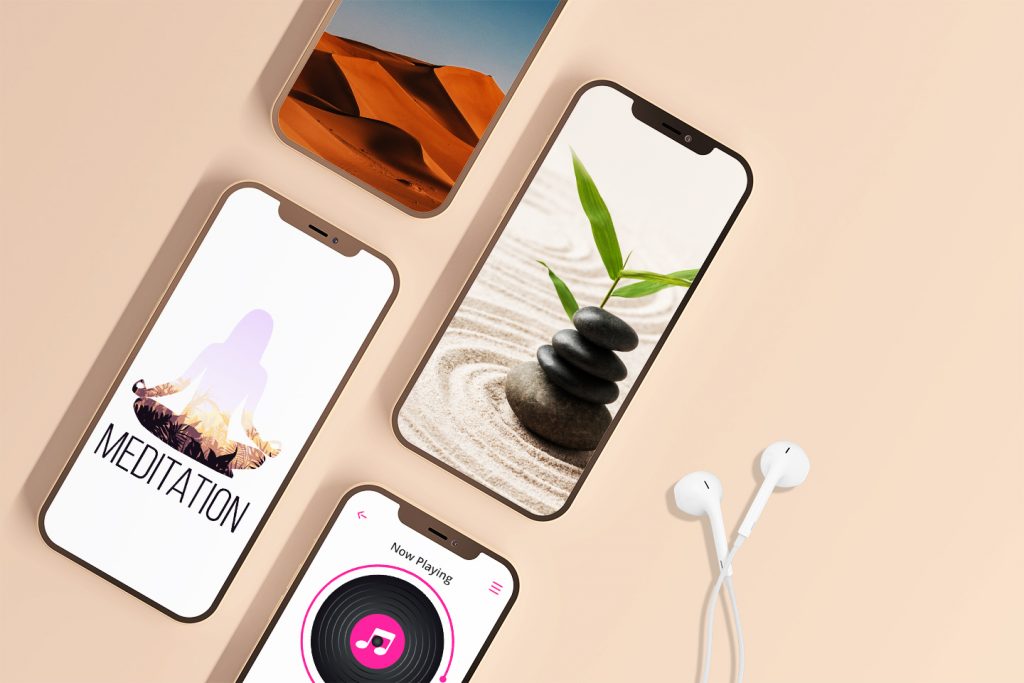
Wellness App – What to Keep in Mind when Creating Apps for Meditation?
Table of Contents
Today’s modern world can often be stressful, but there are benefits too! Instead of having to find in-person, scheduled wellness activities, for example, people can use a wellness app to improve their wellbeing. They can be very effective, quickly, and convenient.
Wellness is all about taking steps toward a healthy and fulfilling life. Many things factor wellness, including sleep, stress, diet, and exercise. Everything we do, and everything we feel, has to do with wellness. It’s a crucial component of a quality life.
We all have daily stress. And we all have parts of our lives that could use a wellness checkup. From meditation to positive thinking, these apps are a pocket-sized support, allowing users to improve wellbeing, whenever, wherever. There is no need to follow a schedule or make an appointment — instead, people can just log on when they need some help.
What is a Wellness App?
How does wellness — spiritual, physical, and intellectual — translate to an app? Wellness apps offer health-related services on devices like smartphones and tablets. The FDA categorizes these apps in two ways:
- The first category consists of general health and wellness apps for awareness.
- The second category comprises apps to diagnose and treat diseases.
Mobile medical apps, the latter, are medical devices according to the FDA. However, apps that simply encourage wellness and promote awareness of it are not considered medical devices. It’s an important distinction for organizations promoting the apps.
Let’s look at a meditation and mindfulness app as an example. These wellness apps typically fall into the first category, as the exercises are not there for treatment but for awareness. An app like this might teach a user how to meditate with a guided approach, perfect for beginners. It’s like training for the brain, usually tracking how long and how frequently a user meditates.
The gamification of mindfulness techniques through wellness apps can encourage people to stick with the practice long enough to build a habit. Studies on apps, particularly Headspace, show that users are better able to act with awareness and not overreact to thoughts and feelings. They are less tired and less burned out, with more positive emotions.

Every wellness app works differently, which means that results will vary from app to app and user to user. Still, a wellness app is an easy, simple, and affordable entry to wellbeing for many people.
Wellness Apps: Market Insights
For app developers and organizations considering releasing their own wellness apps, market statistics are important! Research from 2020 shows that global user spending on wellness apps is rising, proof positive for investing in this industry.
The research indicates that global user spending on the top 10 highest-earning mobile mediation apps increased by 52 percent from 2019 to 2020. The market reached $195 million. And, from 2015 to 2019, the compound annual growth rate of combined revenue reached 121 percent.
Other market research indicates that the global mindfulness and meditation apps market could reach $4206.12 million by 2027. The factors driving this growth include rising cases of mood disorders and more people with disposable income becoming aware of these apps. As the report notes, millennials are the most stressed generation in the 21st century, according to the American Psychological Association. That is the generation that is willing to turn to technology for help.
Now is the time to get in on the market for wellness apps. Next, we’ll outline how to develop these apps, challenges to overcome, and we’ll show you a few real-world examples of successful apps.
Developing a Wellness App
Looking at the volume of the global mindfulness and meditation apps market, it seems to be the best time to join in and create your own wellness app that can help make a real improvement to the mental health and wellbeing of many people. Let’s find out what relevant issues you should consider when developing apps for wellness and relaxation.
Customer research
The first step to developing a wellness app is customer research. Most apps are targeted to a certain audience, whether by age, region, or specific wellness concerns. Consider what is a good fit for your organization and dig in to discover whether or not your idea is viable.
One tactic is to start with a problem. What is your app designed to solve? Once you know that answer, evaluate competitors who are offering the same solution or targeting the same audience. How will your app be different? You can also engage with customers directly, discovering their pain points and testing the app’s concept to find out if it solves their problems.
Type of app
You will also want to decide what type of app you want to provide. Will it be focused specifically on meditation and mindfulness, or include other aspects of wellness? The next question will be whether meditations should be guided or unguided. What kind of mediation should it include: for better sleep or fighting back against worry? Should it offer yoga, workout or breath exercises? Are you going to focus on visuals, music, or on a narration when offering meditations? Will you market it to iOS and Android users, or just one platform?

Key Features
In considering your app, list the features that matter most, mapping out optional features too. For meditation apps, guided meditation is a key feature, teaching your users the skills they need. It’s a good idea to provide sessions that meet various needs, from encouraging sleep to managing stress.
First of all, you should keep users engaged by taking care of the interesting content library that is well structured and searchable. On the top of playlists you should allow the app users to bookmark their favourite tracks and implement machine learning that can analyze user preferences and make recommendations for similar tracks.
Add media playback functionality and nice-looking images for every soundtrack. Both audio and video recordings should be of high quality, namely recorded with professional equipment. Mind your visuals as colours have a great effect on users’ perception. Therefore, select images in soothing colors that can help relax.
Make onboarding engaging and appealing to explain to the user in a simple way what you’re offering with your app. It’s important to take care of personal profiles for users enabling them to check subscription plans, change settings, add photos and customize notifications. Tracking of a personal progress or gamification element can keep people engaged and wanting to continue down the path of wellbeing.
Push notifications encourage users to return to the app if they haven’t used it in a while. Integration with social media platforms adds a community element to your app, so people can show off their mindfulness skills.
Again, every app will have its own features, but make sure you get the crucial key features in place.
Security
Consider security, as this is a feature users will want to know is in place. While meditation apps may not be considered medical devices, users still want to know that their wellness information is protected. Make security a priority on your end, with your developer, and offer additional user features like PIN protection.
Monetization strategy
You will also need to decide if and how you will monetize your app. Many wellness apps operate with a subscription model, in which users start with a free trial then transition to monthly, annual, or even lifetime subscriptions. Others use in-app purchase options to extend the free version, enticing users to expand on the basic options.
There are also pay per download wellness apps, though those are often less popular. Many users are reluctant to pay for an app without having the opportunity to try it, and companies may lose a cut of the money to transaction fees. Some apps include ads to make money, but this is often frustrating for users, and counter to the idea of an app that promotes distraction-free wellbeing.
If you have an idea for an app or a feature within an app, and aren’t sure if it will work, a developer can help bring your plans to life in a realistic way. For inspiration, check out these real-world examples.
Examples of Wellness Apps
To show the diversity in wellness apps, here are a few popular downloads.
Calm
Among the apps for relaxation and wellbeing, Calm is a well-known name. With over 100 million downloads, it’s an app that people love for sleep, meditation, and relaxation. Calm offers sleep and meditation guidance, as well as exclusive music, videos on mindful movement and stretching, and masterclasses from experts.
Users pay $69.99 annually to use Calm or have the option of a one-time payment to get Calm for life. That’s $399.99. With both subscriptions, users get hundreds of hours of guided or unguided meditation, music, over 100 sleep stories, masterclasses, and all of the Calm Body videos. There is also a free version, with timed meditation, samples of multi-day meditation programs, a breathing exercise, and a sleep story, as well as several free ‘scenes’ with nature and music.
Headspace
Headspace is another option, offering 500+ meditations that focus on topics from stress to compassion. This app also promotes good sleep, with specifically designed sounds, music, and exercises. Headspace offers workouts, yoga, focused playlists, and other features designed to maximize wellness.
All of Headspaces’s meditations are guided, slightly different than Calm which offers guided or unguided. It comes in at a similar cost: $12.99 per month or $69.99 per year. Students can take advantage of a $9.99 per year student plan. Families can log on together with a $99.99/year family plan. A free version allows for the first level of the Basics course, ten sessions of meditation. There are also three sessions of Today’s Meditation, a few quick workouts, one popular sleep session, two additional sleep mode modules, and a focus music playlist. Free users also have access to Dive in Well, stories from people with diverse perspectives.

Simple Habit
Simple Habit is a popular wellness app for those who want quick meditation help. The meditations offered on this app are all five-minute exercises tailored to various situations. The key word is ‘simple’ — the meditations are quick and easy, and the app is easy to use.
Pricing is similar to the big-name Headspace and Calm apps. Paying month by month costs $11.99, while paying yearly is $89.99. However, a lifetime membership is much cheaper, at $299.99. Users who pay for the premium version of Simple Habit get 2000+ meditations with new versions uploaded weekly. You can download meditations to have access even without phone service, and the company offers a community platform to connect with fellow meditators.
Insight Timer
Finally, on the list of popular meditation and wellness apps, there’s Insight Timer. Listed as the number one free app for sleep, anxiety and stress, the company says that ‘magic happens when you give meditation away for free. The app offers thousands of free guided meditations, with no time limit, and no cost.
While many apps offer starter packs that entice users into buying premium content, Insight Timer puts it out there for free. It starts with a seven-day educational course, and continues with themed meditations, talks, and courses. Users can track their progress with charts and milestones, and believe it or not, there are no ads. A paid version of Insight Timer, called Member Plus, offers comprehensive courses and playlists, as well as daily insights. That comes at a cost of $59.99 a year, or $9.99 a month.
Work with Us to Develop Your Wellness App
Are you inspired by this information about apps for relaxation and wellbeing? If you need a partner to bring your ideas to life, we’re exactly what you need. Our team at Concise Software has over 15 years of experience creating and developing mobile apps for all kinds of companies.
There are countless benefits to these apps for both users and the organizations who provide the apps. Users have another way to de-stress and encourage themselves to be the best they can be, while organizations get the satisfaction of meeting customer needs, and another profit stream.
Our development work is designed to save time and optimize your costs so you can get your app to market quickly, without going over budget. With plenty of experience specifically developing apps for healthcare, we also know how to handle privacy and compliance concerns. Whatever your vision may be, we’re confident we can play an important role in getting your product to your customers.
Send us an email or fill in our contact form, describing your idea. We’ll get back to you quickly with some ideas, and arrange a meeting either face-to-face or using virtual technology. Our experts will work with you to understand the details of your idea, and provide technical knowledge.
Then, we provide a detailed estimate of costs and timeline, with additional valuations based on extra features you might want to include. This estimate is free, so you’re not on the hook for anything! With your approval we design the app, perfect it, test it and turn it over, checking in for approval at every step.
We look forward to working with you! You can email us at success@concisesoftware.com or use our contact form which is available at the click of a button.
More about apps:
Looking for image recognition app? Here’s everything you need
How to Create a Dating App That Meets User Expectations
Diet & nutrition apps: How to Create Apps Serving Nutritional Guidelines?
Fitness Apps – How to Keep Your App Development on Track
Saving water – 8 useful water conservation apps to calculate water footprint
Why should you consider creating medical app and how to do that?